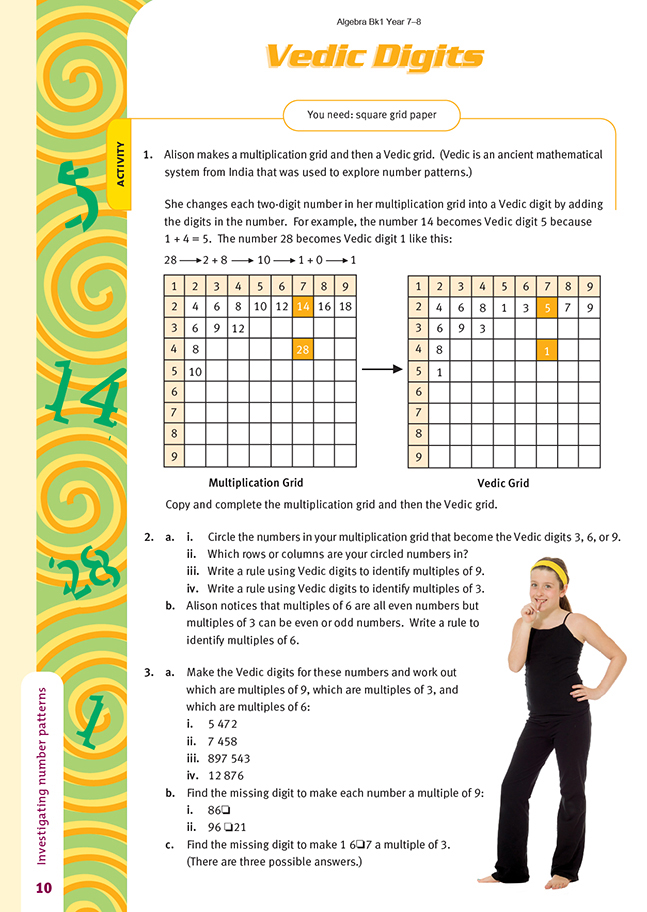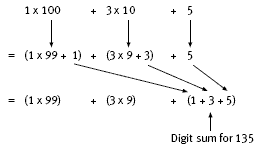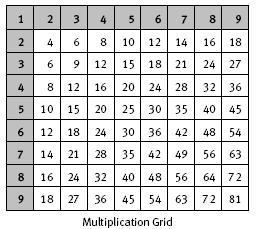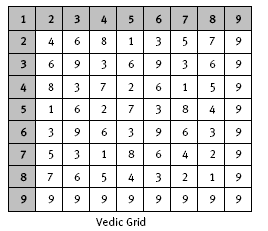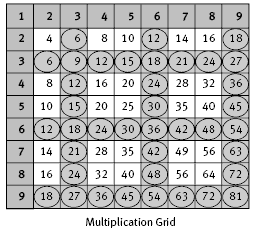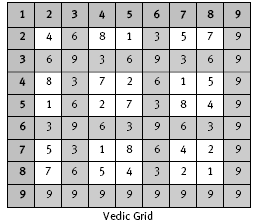This is a level 3 number strand link activity from the Figure It Out series.
A PDF of the student activity is included.
Click on the image to enlarge it. Click again to close. Download PDF (181 KB)
find multiples of 3, 6, and 9
FIO, Link, Algebra, Book One, Vedic Digits, page 10
sqaure grid paper
Vedic mathematics is an ancient form of Hindu mathematics. Vedic techniques are designed to simplify multiplication, divisibility, finding squares, square roots, cubes, cube roots, and other aspects of mathematics, including working with recurring decimals and fractions.
This activity focuses on aspects of divisibility and multiples. For example, a number is divisible by 9 if the sum of its digits is a multiple of 9. The mathematics underlying this is as follows.
Numbers such as 135 can be expressed in expanded form as 1 x 100 + 3 x 10 + 5. This tells us that 135 is not a multiple of 10 because the last digit, 5, is not a multiple of 10. We can also write the expanded form for 135 in a different way: (1 x 99 + 1) + (3 x 9 + 3) + 5. The links between the two ways of writing 135 are shown below.
Note that the last bracketed term is just the digit sum for 135. So 135 = 1 x 99 + 3 x 9 + 9. We know that 1 x 99 is a multiple of 9 because 9 x 11 = 99. 3 x 9 is also a multiple of 9, and so is the digit sum 1 + 3 + 5 = 9. So we can say that 135 is a multiple of 9. In fact, to decide if any number is a multiple of 9 (or is divisible by 9), all we need to do is to look at the digit sum and see if this digit sum is itself a multiple
of 9. Using short cuts like this is what is meant by Vedic mathematics.
Sometimes the digit sum has more than one digit. When this occurs, the students need to repeat this process until the digit sum is a single digit. We have called this digit the Vedic digit for the number. For example, 2 389 has the digit sum 2 + 3 + 8 + 9 = 22. The digit sum for 22 is 2 + 2 = 4. So the Vedic digit for 2 389 is 4, which indicates that 2 389 is not a multiple of 9.
The mathematics above is not included in the activity for the students, but it does provide a background to the activities in which the students use patterns in their completed Vedic grids to devise rules for identifying multiples of 9, 6, and 3 (see questions 1 and 2).
It may be useful to put the following questions to the students to develop their thinking about multiples and divisibility:
Question: Are all multiples of 6 and 9 also multiples of 3? Why or why not?
Answer: Yes. 6 and 9 are themselves multiples of 3, so the product formed when any (whole) number is multiplied by 6 or 9 will also be divisible by 3 and be a multiple of 3. For example, 12 (a multiple of 6) is also a multiple of 3, and 18 (a multiple of both 6 and 9) is also a multiple of 3.
Question: Are all multiples of 9 also multiples of 6? Why or why not?
Answer: No. A number such as 27 is a multiple of 9 but not of 6. Multiples of 9 are sometimes odd (as with 27) but multiples of 6 are always even.
In question 3a, the students start by using their rules to check which numbers are multiples of 9, 3, or 6. (They will find that all the numbers are multiples of 3 but that not all are multiples of 6 or 9.) In question 3b, they use their rules to find the missing digits in a 3-digit number and a 5-digit number that are multiples of 9. There are two possible answers for 96 21 in this question and three possible answers for 1 67 in question 3c. The three possible missing digits for 1 6 7 give the Vedic digits 6, 9, and 3 respectively.
Answers to Activity
1.
2. a. i.
ii.
The circled numbers are in rows and columns that are multiples of 3, 6, and 9.
iii. A number is a multiple of 9 when its Vedic digit is 9.
iv. A number is a multiple of 3 when its Vedic digit is 3, 6, or 9.
b. A number is a multiple of 6 when it is an even number and its Vedic digit is 3, 6, or 9.
3. a. i. The Vedic digit is 9. So 5 472 is a multiple of 3, 6 (5 472 is an even number), and 9.
ii. The Vedic digit is 6. So 7 458 is a multiple of 3 and 6 (7 458 is an even number) but not 9 (the Vedic digit is not 9).
iii. The Vedic digit is 9. So 897 543 is a multiple of 3 and 9 but not 6 (897 543 is not an even number).
iv. The Vedic digit is 6. So 12 876 is a multiple of 3 and 6 but not 9.
c. 1 617, 1 647, or 1 677
